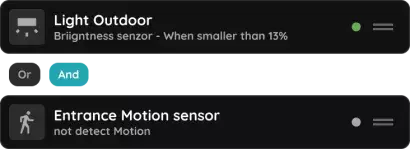On this page
Pierre is compatible with all types of lighting, including regular light bulbs, LED strips, and LED lamps, operating at both 230V and low-voltage systems like 12V or 24V. The system can control RGB lighting and support dimming functions for various light sources. However, when working with LED lamps, it is important to ensure that they are specifically designed as dimmable.
Key Lighting Controls:
• On/Off Control: Lights can be set to simply turn on or off as needed.
• Auto Mode: Automation can adjust the lighting based on environmental triggers.
• Scenarios: Lights can be integrated into custom scenes, where multiple devices respond simultaneously to user preferences.
Types of Dimming Methods:
1. Phase-Cut Dimming: Widely used for incandescent, halogen, and some LED lights, this method adjusts light output by cutting off part of the AC voltage waveform. It is available in leading-edge or trailing-edge variants, depending on the light source.
2. 0-10V Dimming: Often used for fluorescent and some LED lights, this method involves sending a 0-10V signal to the driver or ballast, which controls light brightness by varying the voltage.
3. PWM Dimming (Pulse Width Modulation): Common for LED lights, PWM rapidly switches the lights on and off at a high frequency, adjusting brightness by varying the pulse width. This provides precise, flicker-free dimming.
LED Drivers and Dimming:
• Constant-Current Drivers: Provide a fixed current for LEDs and are typically used for dimming with constant current reduction (CCR).
• Constant-Voltage Drivers: Maintain a fixed voltage and can also offer dimming via PWM or CCR.
When selecting LED lamps for dimming, it’s important to review the LED specifications to ensure compatibility with the dimming technology. If the LED specifications don’t mention dimming, it’s safer to assume the lamp is not dimmable.


| Position | Wires | Diameter | Type | Comment |
|---|---|---|---|---|
| 230V AC to Dimmer | 2 | 1.5 mm² | PP/Y | L, N |
| Dimmer to Led | 2 | 0.75 mm² | PF | GND, Output |
| From Dimmer to Pierre | 2 | cat.5 | UTP | GND, SIGNAL |
| From Push button to Pierre | 2 | cat.5 | UTP | +12V, SIGNAL |
| 0-10 V Dimmer to Bulb | 2 | 1.5 mm² | PP/Y | L, N |
What color mean what on Controller LED?
Green – Online:
The controller is online and connected to the network, functioning as expected.
Red – Offline:
The controller is offline, indicating a disconnection from the network or that there is no internet access.
Light Blue – AP Mode:
The controller is in Access Point (AP) Mode, meaning it is broadcasting its own network, allowing devices to connect directly to the controller for setup or configuration.
Dark Blue – AP Mode with Pierre Partner:
The controller is in AP Mode, and it is actively being managed through the Pierre Partner system. This mode is used for more advanced setup or partner-level configuration.
Purple – Searching for IP Address:
The controller is attempting to obtain an IP address from the router or network. It is searching for an internet connection.
Orange – Firmware Update:
The controller is in the process of downloading a firmware update, ensuring that the system stays up-to-date with the latest software and features.
These LED color indicators provide essential information about the controller’s current status, making it easy to monitor its connection, operation mode, and maintenance activities.
Are the GND and DIGITAL cables properly connected?
If not: Check the polarity, maybe they are reversed.
Has it been added to configuration?
If not: Add it in the PIERRE Partner application.
Also, check if it's specified within the push button which lamp you want to control.
Does it have an intensity set?
If not: Set higher intensity in the Smart Pierre application - hold the I/O on the dashboard and set the slider higher.
Is it a dimmable PWM LED strip?
If yes: Is the PWM power supply powerful enough for the consumption of the given LED strip? Check the wiring: DIM+ and DIM- are correctly connected to Pierre controller?
Is it a 0-10V lamp?
If yes: Is the Pierre Controller setup for 0-10V control on the specific PIN?
What happens if there is a power outage?
If the power goes out, smart devices will retain their last state and resume functionality when power is restored. For critical devices, battery backups can be used to maintain operation during an outage.
Lights, switches, and other devices except for sockets will be connected in a star pattern, but where should the star point be? Room-by-room, or can everything be in the house’s distribution cabinet?
The PIERRE system uses star wiring, meaning every device to be controlled must be wired to a central location – the distribution box of the PIERRE Controllers. This box can be separated from high-voltage wiring or combined with it. In some cases, star points are created per floor, with each floor having its own PIERRE distribution box. These boxes are all connected to the internet, ensuring complete system integration and control.
How should the lighting be wired?
For lighting, each fixture to be switched separately must have its own wire. If multiple lights are on the same circuit, they can be connected and controlled by a single switch. All wires must be connected to the PIERRE distribution box. The switch wires must also be wired directly to the PIERRE distribution box.
Can the PIERRE system handle 48V magnetic, recessed LED systems and their dimming?
The PIERRE system supports several dimming methods. These include PWM, 0-10V, and phase dimming.



